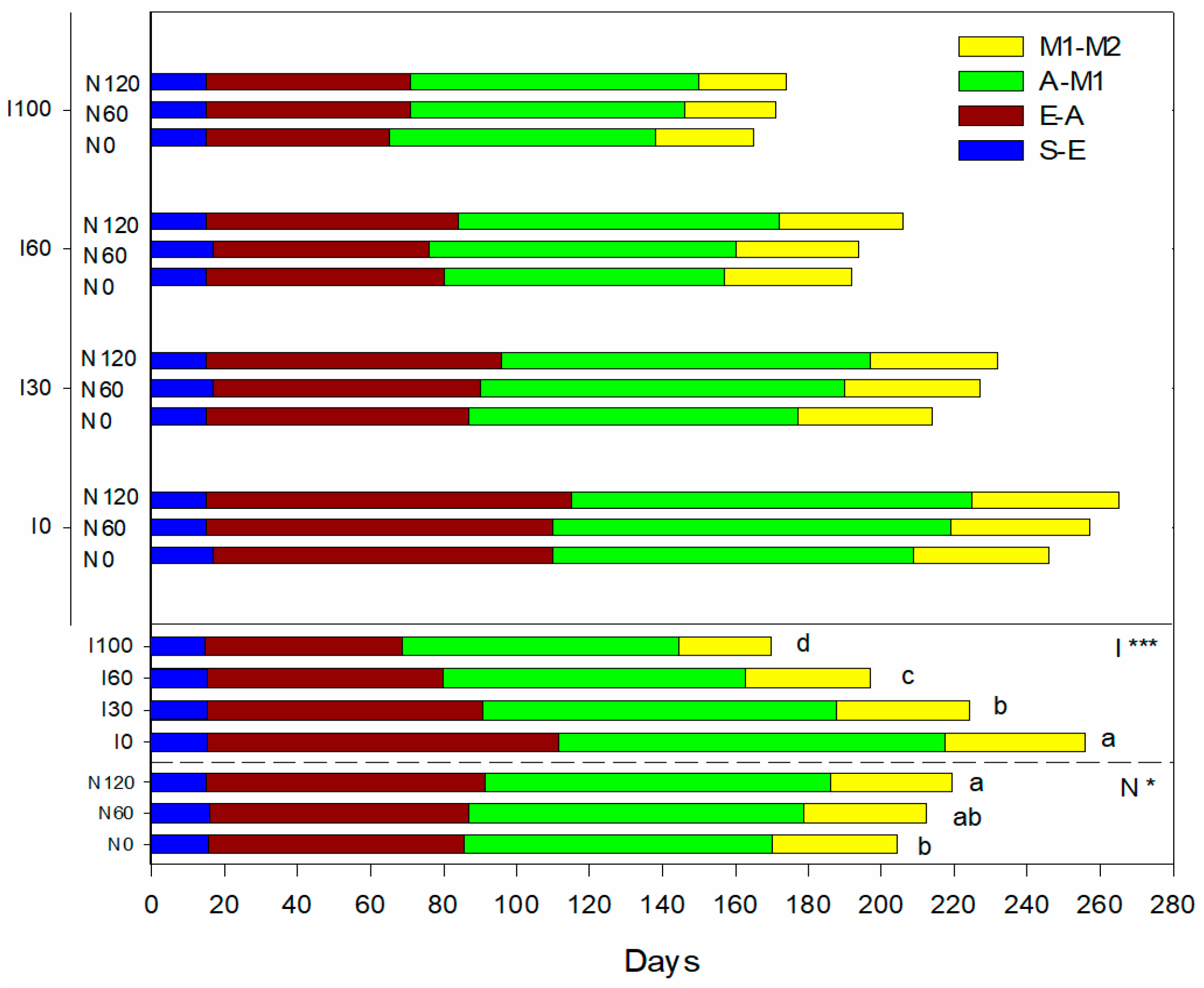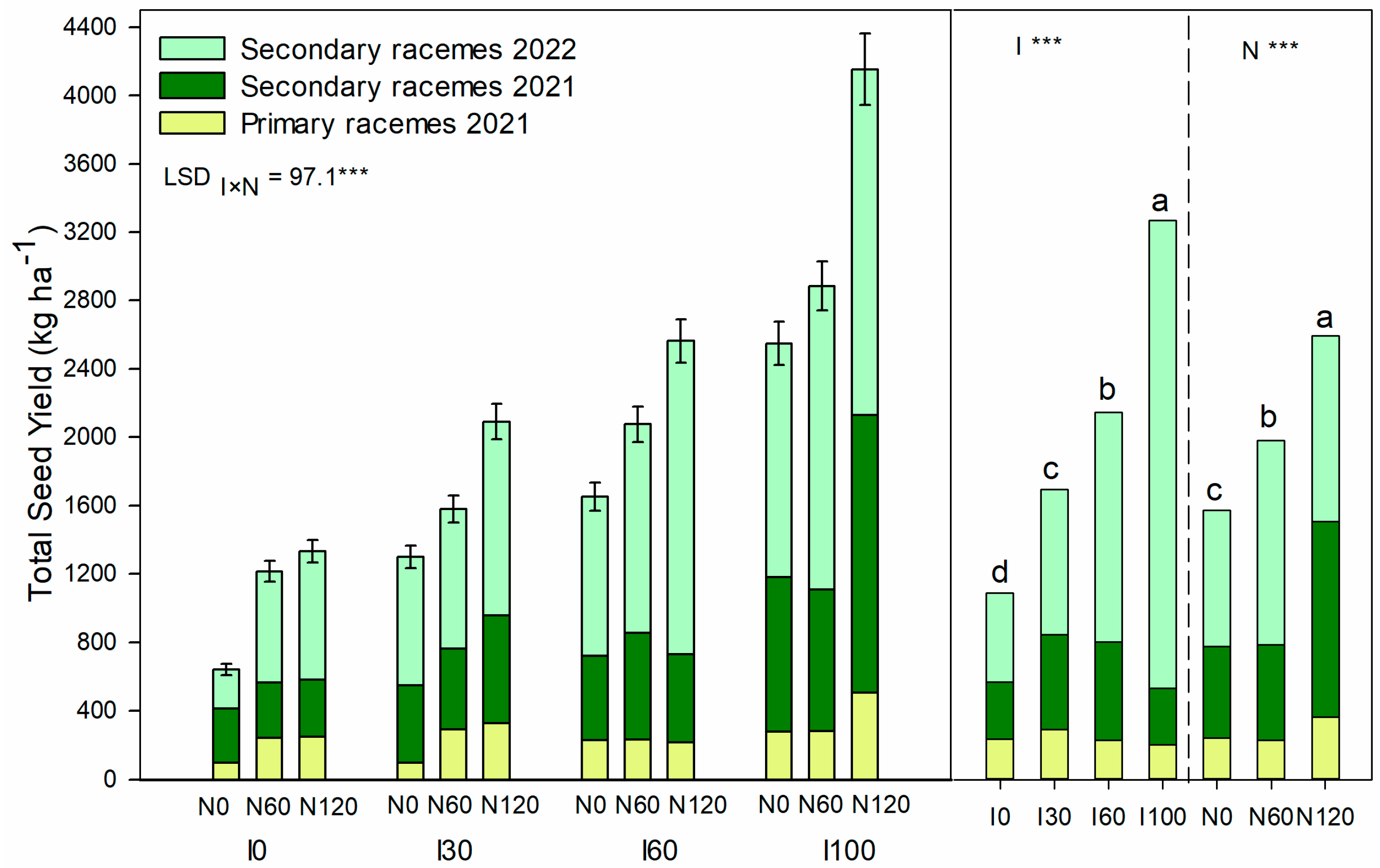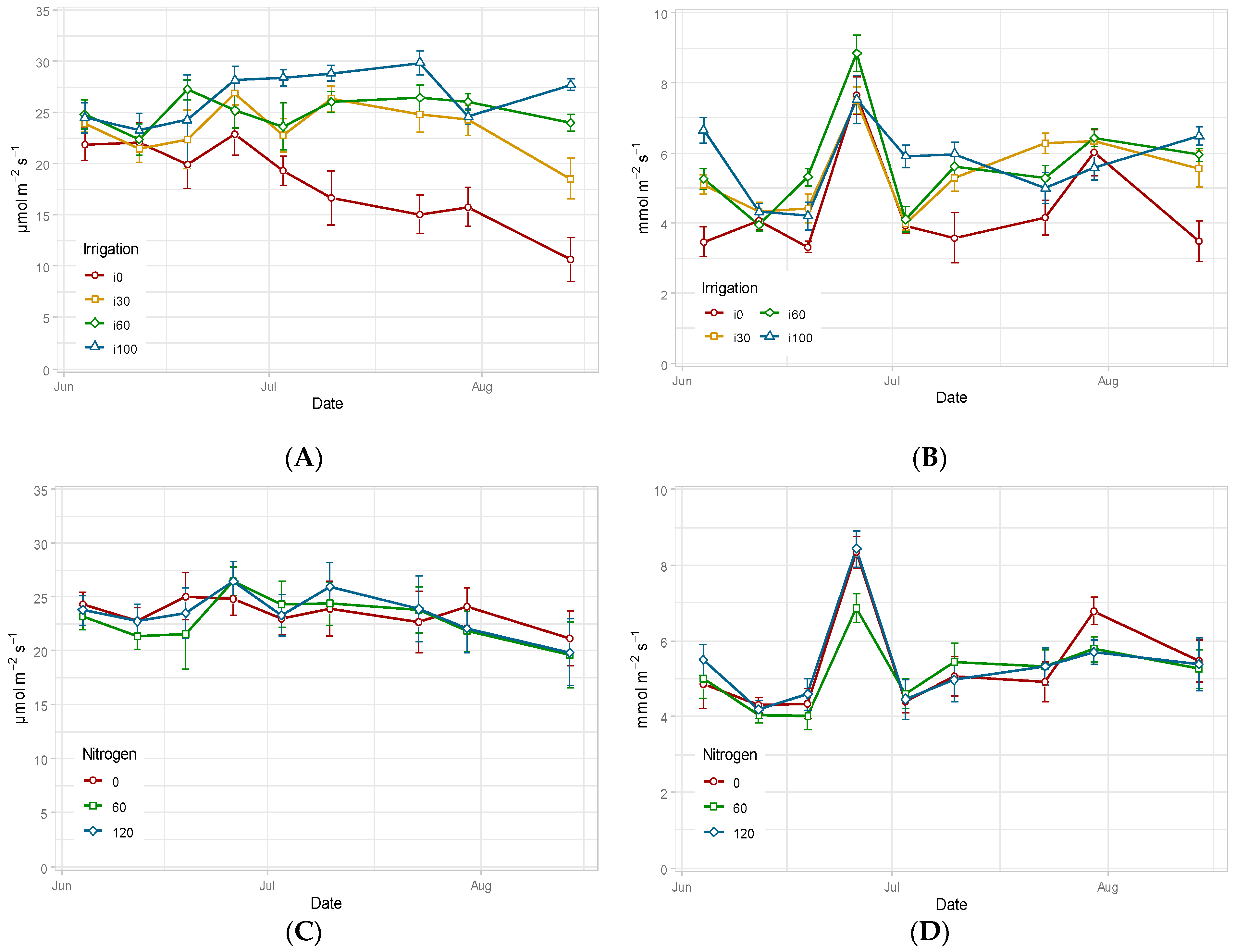Effects of Nitrogen Fertilization and Soil Water Content on Seed and Oil Yield in Perennial Castor in a Mediterranean Environment
Abstract
1. Introduction
2. Materials and Methods
2.1. Field Experiment
2.2. Meteorological Course
2.3. Oil Extraction
2.4. Statistical Analysis
3. Results
3.1. Length of Phenological Stages
3.2. Morphological Traits, Yield, and Yield Components
3.3. Oil Content and Oil Yield
3.4. Water Use Efficiency
3.5. Photosynthesis and Transpiration Rates
4. Discussion
5. Conclusions
Author Contributions
Funding
Data Availability Statement
Conflicts of Interest
References
- Franz, H. The ricin story. Adv. Lectin Res. 1988, 1, 10–25. [Google Scholar]
- Scarpa, A.; Guerci, A. Various uses of the castor oil plant (Ricinus communis L.) a review. J. Ethnopharmacol. 1982, 5, 117–137. [Google Scholar] [CrossRef]
- Weiss, E.A. (Ed.) Castor. In Oilseed Crops; Blackwell Science: Oxford UK, 2000; Volume 261, pp. 13–52. [Google Scholar]
- Moshkin, V.A. (Ed.) Castor; Amerind: New Delhi, India, 1986. [Google Scholar]
- Anjani, K. Castor genetic resources: A primary gene pool for exploitation. Ind. Crops Prod. 2012, 35, 1–14. [Google Scholar] [CrossRef]
- Fernández-Martínez, J.M.; Velasco, L. Castor. In Technological Innovations in Major World Oil Crops; Gupta, S.K., Ed.; Springer: New York, NY, USA, 2012; Volume 1: Breeding, pp. 237–265. [Google Scholar]
- Babita, M.; Maheswari, M.; Rao, L.M.; Shanker, A.K.; Rao, D.G. Osmotic adjustment, drought tolerance and yield of castor (Ricinus communis L.) hybrids. Environ. Exp. Bot. 2010, 69, 243–249. [Google Scholar] [CrossRef]
- Nahar, K. Castor bean (Ricinus communis L.)—A biofuel plant: Morphological and physiological parameters propagated from seeds in Bangladesh. Asian Bus. 2013, 2, 64–66. [Google Scholar] [CrossRef]
- Severino, L.S.; Auld, D.L. A framework for the study of the growth and development of castor plant. Ind. Crops Prod. 2013, 46, 25–38. [Google Scholar] [CrossRef]
- Ogunniyi, D. Castor oil: A vital industrial raw material. Bioresour. Technol. 2006, 97, 1086–1091. [Google Scholar] [CrossRef] [PubMed]
- Dias, J.M.; Araújo, J.M.; Costa, J.F.; Alvim-Ferraz, M.C.M.; Almeida, M.F. Biodiesel production from raw castor oil. Energy 2013, 53, 58–66. [Google Scholar] [CrossRef]
- Keera, S.T.; El Sabagh, S.M.; Taman, A.R. Castor oil biodiesel production and optimization. Egypt. J. Pet. 2018, 27, 979–984. [Google Scholar] [CrossRef]
- Arnaud, F. The development of castor-oil crops in France. In Il Ricino: Obiettivi, Strategie e Ricerca; Agricoltura Ricerca, Ministero Agricoltura e Foreste: Rome, Italy, 1990. [Google Scholar]
- Baldanzi, M.; Benvenuti, A. An ideotype of castor (Ricinus communis L.) for the Mediterranean environment. Agric. Med. 1995, 125, 16–20. [Google Scholar]
- Koutroubas, S.D.; Papakosta, D.K.; Doitsinis, A. Adaptation and yielding ability of castor plant (Ricinus communis L.) genotypes in a Mediterranean climate. Eur. J. Agron. 1999, 11, 227–237. [Google Scholar] [CrossRef]
- Laureti, D.; Marras, G. Irrigation of castor (Ricinus communis L.) in Italy. Eur. J. Agron. 1995, 4, 229–235. [Google Scholar] [CrossRef]
- Weiss, E.A. Oilseed Crops; Longman: New York, NY, USA, 1983; 660p. [Google Scholar]
- Falasca, S.L.; Ulberich, A.C.; Ulberich, E. Developing an agro-climatic zoning model to determine potential production areas for castor bean (Ricinus communis L.). Ind. Crops Prod. 2012, 40, 185–191. [Google Scholar] [CrossRef]
- Zanetti, F.; Chieco, C.; Alexopoulou, E.; Vecchi, A.; Bertazza, G.; Monti, A. Comparison of new castor (Ricinus communis L.) genotypes in the mediterranean area and possible valorization of residual biomass for insect rearing. Ind. Crops Prod. 2017, 107, 581–587. [Google Scholar] [CrossRef]
- Patanè, C.; Cosentino, S.L.; Corinzia, S.A.; Testa, G.; Sortino, O.; Scordia, D. Photothermal zoning of castor (Ricinus communis L.) growing season in the semi-arid Mediterranean area. Ind. Crops Prod. 2019, 142, 111837. [Google Scholar] [CrossRef]
- Ramanjaneyulu, A.V.; Vishnuvardhan Reddy, A.; Madhavi, A. The impact of sowing date and irrigation regime on castor (Ricinus communis L.) seed yield, oil quality characteristics and fatty acid composition during post rainy season in South India. Ind. Crops Prod. 2013, 44, 25–31. [Google Scholar] [CrossRef]
- Anastasi, U.; Sortino, O.; Cosentino, S.L.; Patanè, C. Seed yield and oil quality of perennial castor bean in a Mediterranean environment. Int. J. Plant Prod. 2015, 9, 99–116. [Google Scholar]
- AOAC. Official Methods of Analysis of the Association of Official Analytical Chemists, 15th ed.; Kenneth, H., Ed.; The Association of Official Analytical Chemists, Inc.: Arlington, VA, USA, 1990; Volume 1. [Google Scholar]
- Rios, G.F.A.; Carvalho, L.G.; Silva Junior, J.J.; Neto, P.C.; Fraga, A.C. Method and phenological characterization of the stadiums and phases of the development of castor bean plants. Afr. J. Agric. Res. 2016, 11, 4488–4497. [Google Scholar] [CrossRef]
- Randall, E.L. Improved Method for Fat and Oil Analysis by a New Process of Extraction. J. AOAC Int. 1974, 57, 1165–1168. [Google Scholar] [CrossRef]
- Lakshmamma, P.; Lakshmi, Y.; Mohan, C.; Lavanya, C. Genetic variability and character association in castor (Ricinus communis L.). Nat. J. Plant Improv. 2005, 7, 122–126. [Google Scholar]
- Ramesh, T.; Venkate, S. Path coefficient analysis in castor. Agric. Sci. Dig. 2001, 21, 59–60. [Google Scholar]
- Severino, L.S.; Auld, D.L. Seed Yield and Yield Components of Castor Influenced by Irrigation. Ind. Crops Prod. 2013, 49, 52–60. [Google Scholar] [CrossRef]
- Koutroubas, S.D.; Papakosta, D.K.; Doitsinis, A. Water requirements for castor oil crop (Ricinus communis L.) in a Mediterranean climate. J. Agron. Crop Sci. 2000, 184, 33–34. [Google Scholar] [CrossRef]
- Singer, S.D.; Zou, J.; Weselake, R.J. Abiotic factors influence plant storage lipid accumulation and composition. Plant Sci. 2016, 243, 1–9. [Google Scholar] [CrossRef] [PubMed]
- Diniz Neto, M.A.; Távora, F.J.A.F.; Crisóstomo, L.A.; Diniz, B.L.M.T. NPK fertilization and sowing time for castor plant. I—production and yield components. Rev. Ciênc. Agron. 2009, 40, 578–587. [Google Scholar]
- Soratto, R.P.; Souza-Schlick, G.D.; Giacomo, B.M.S.; Zanotto, M.D.; Fernandes, A.M. Low-height castor bean row spacing and plant population for mechanical harvest. Pesqui. Agropecu. Bras. 2011, 46, 245–253. [Google Scholar] [CrossRef]
- Souza, A.S.; Távora, F.J.A.F.; Pitombeira, J.B.; Bezerra, F.M.L. Planting time and irrigation management for castor plant. I—effect on yield components. Rev. Ciênc. Agron. 2007, 38, 414–421. [Google Scholar]
- Souza-Schlick, G.D.; Soratto, R.P.; Bottino, D.; Fernandes, A.M. Growth and yield of short height castor on different row spacings and plant populations. Interciencia 2012, 37, 49–54. [Google Scholar]
- Soratto, R.P.; Souza-Schlick, G.D.; Fernandes, A.M.; Zanotto, M.D.; Crusciol, C.A.C. Narrow row spacing and high plant population to short height castor genotypes in two cropping seasons. Ind. Crops Prod. 2012, 35, 244–249. [Google Scholar] [CrossRef]
- Laureti, D.; Fedeli, A.M.; Scarpa, G.M.; Marras, G.F. Performance of castor (Ricinus communis L.) cultivars in Italy. Ind. Crops Prod. 1998, 7, 91–93. [Google Scholar] [CrossRef]
- Fanan, S.; Medina, P.F.; Camargo, M.B.P. Description of agronomic characteristics and harvest evaluation in the yield of castor bean cultivar. Bragantia 2009, 68, 415–422. [Google Scholar] [CrossRef]
- Zuchi, J.; Zanuncio, J.C.; Bevilaqua, G.A.P.; Peske, S.T.; Silva, S.D.A. Castor yield components according to floral order and sowing season in the Rio Grande do Sul State. Rev. Ciênc. Agron. 2010, 41, 380–386. [Google Scholar] [CrossRef]
- Nagabhushanam, U.; Raghavaiah, C.V. Seeding date and irrigation effects on the productivity and oil quality of post monsoon grown castor. J. Oilseeds Res. 2005, 22, 206–208. [Google Scholar]
- Farahani, H.A.; Aref, B. Effect Of plant densıty on oil yield of castor (Ricinus communis L) in application of nitrogen levels conditions. Afr. J. Tradit. Complement. Altern. Med. AJTCAM 2008, 6, 336. [Google Scholar]
- Sawana, Z.M.; Hafezb, S.A.; Basyonyb, A.E.; Alkassasb, A.R. Nitrogen, potassium and plant growth retardant effects on oil content and quality of cotton seed. Grasas Aceites 2007, 58, 243–251. [Google Scholar] [CrossRef]
- Patel, K.S.; Patel, P.G.; Patel, G.N.; Patel, J.K.; Pathak, H.C. Feasibility of drip irrigation in castor under sandy loam soil of North Gujarath. J. Oilseeds Res. 2004, 21, 194–195. [Google Scholar]
- Sesha Saila Sree, P.; Bhaskar Reddy, B. Effect of tillage and soil moisture regimes on seedling emergence, growth and yield of summer castor in rice fallows. J. Oilseeds Res. 2005, 22, 327–330. [Google Scholar]
- Ramanjaneyulu, A.V.; Ramprakash, T.; Vishnuvardhan Reddy, A. Effect of sowing date and irrigation scheduling on yield and economics of winter castor in Southern Telangana Zone of Andhra Pradesh. J. Oilseeds Res. 2010, 27, 180–181. [Google Scholar]





| Number of Secondary Racemes | ||||||||||
|---|---|---|---|---|---|---|---|---|---|---|
| N0 | N60 | N120 | Mean | |||||||
| T2 | T3 | T2 | T3 | T2 | T3 | N0 | N60 | N120 | ||
| I0 | 2.0 | 4.2 | 2.5 | 5.5 | 1.01 | 8.4 | 3.1 | 4.0 | 4.7 | 3.9 c |
| I30 | 2.0 | 10.7 | 1.5 | 8.5 | 2.0 | 6.0 | 6.4 | 5.0 | 4.0 | 5.1 b |
| I60 | 1.4 | 8.8 | 2.0 | 7.8 | 2.0 | 9.8 | 5.1 | 4.9 | 5.9 | 5.3 b |
| I100 | 3.5 | 9.3 | 2.5 | 10.3 | 4 | 11.8 | 6.4 | 6.4 | 7.9 | 6.9 a |
| Mean | 2.2 | 8.3 | 2.1 | 8.0 | 2.3 | 9.0 | 5.2 b | 5.1 b | 5.6 a | 5.3 |
| Number of Capsules | |||||||||||||
|---|---|---|---|---|---|---|---|---|---|---|---|---|---|
| N0 | N60 | N120 | Mean | ||||||||||
| T1 | T2 | T3 | T1 | T2 | T3 | T1 | T2 | T3 | N0 | N60 | N120 | ||
| I0 | 21.0 | 29.0 | 10.0 | 45.0 | 32.0 | 27.0 | 36.0 | 36.0 | 22.0 | 20.0 | 34.7 | 31.3 | 28.7 b |
| I30 | 24.2 | 32.5 | 17.0 | 34.0 | 43.5 | 18.0 | 31.0 | 35.5 | 16.0 | 24.6 | 31.8 | 27.5 | 28.0 b |
| I60 | 26.0 | 25.5 | 20.0 | 30.0 | 36.0 | 21.0 | 29.5 | 47.0 | 23.0 | 23.8 | 29.0 | 33.2 | 28.7 b |
| I100 | 59.0 | 32.0 | 22.0 | 43.3 | 41.0 | 27.0 | 66.2 | 38.0 | 30.0 | 37.7 | 37.1 | 44.7 | 39.8 a |
| Mean | 32.6 | 29.8 | 17.3 | 38.1 | 38.1 | 23.3 | 40.7 | 39.1 | 22.8 | 26.5 b | 33.2 a | 34.2 a | 31.3 |
| Seed Weight (g) | |||||||||||||
|---|---|---|---|---|---|---|---|---|---|---|---|---|---|
| N0 | N60 | N120 | Mean | ||||||||||
| T1 | T2 | T3 | T1 | T2 | T3 | T1 | T2 | T3 | N0 | N60 | N120 | ||
| I0 | 0.32 | 0.36 | 0.27 | 0.34 | 0.4 | 0.28 | 0.48 | 0.41 | 0.38 | 0.32 | 0.34 | 0.42 | 0.36 b |
| I30 | 0.24 | 0.38 | 0.29 | 0.42 | 0.37 | 0.35 | 0.44 | 0.4 | 0.36 | 0.30 | 0.38 | 0.40 | 0.36 b |
| I60 | 0.46 | 0.49 | 0.43 | 0.44 | 0.55 | 0.39 | 0.4 | 0.27 | 0.38 | 0.46 | 0.46 | 0.35 | 0.42 a |
| I100 | 0.23 | 0.39 | 0.32 | 0.31 | 0.58 | 0.33 | 0.35 | 0.42 | 0.43 | 0.31 | 0.41 | 0.40 | 0.37 b |
| Mean | 0.31 | 0.41 | 0.33 | 0.38 | 0.48 | 0.34 | 0.42 | 0.38 | 0.39 | 0.35 b | 0.40 a | 0.39 a | 0.38 |
| Oil Content (%) | |||||||||||||
|---|---|---|---|---|---|---|---|---|---|---|---|---|---|
| N0 | N60 | N120 | Mean | ||||||||||
| T1 | T2 | T3 | T1 | T2 | T3 | T1 | T2 | T3 | N0 | N60 | N120 | ||
| I0 | 30.4 | 29.6 | 50.6 | 44 | 38.9 | 46.5 | 40.6 | 40.3 | 48.4 | 36.9 | 43.1 | 43.1 | 41.0 a |
| I30 | 35.2 | 37.2 | 46.2 | 42.1 | 37.1 | 45.8 | 44 | 38.3 | 43.6 | 39.5 | 41.7 | 42.0 | 41.1 a |
| I60 | 45.3 | 36.5 | 44.2 | 47.2 | 39.8 | 46.5 | 44 | 30.8 | 43.1 | 42.0 | 44.5 | 39.3 | 41.9 a |
| I100 | 35.8 | 45.3 | 43.6 | 37.8 | 46.3 | 46.1 | 34.5 | 41.8 | 42.4 | 41.6 | 43.4 | 39.6 | 41.5 a |
| Mean | 36.7 | 37.2 | 46.2 | 42.8 | 40.5 | 46.2 | 40.8 | 37.8 | 44.4 | 40.0 b | 43.2 a | 41.0 b | 41.4 |
| Source of Variance | Number of Racemes | Number of Capsules | Seed Weight (g) | Seed Yield (kg ha−1) | Oil Content (%) | Oil Yield (kg ha−1) |
|---|---|---|---|---|---|---|
| I | *** | *** | *** | *** | *** | |
| N | **** | *** | ** | *** | ** | *** |
| T | *** | *** | *** | *** | *** | |
| I × N | *** | ** | *** | *** | * | ns |
| I × T | *** | *** | * | *** | ** | *** |
| N × T | *** | ns | ns | *** | * | *** |
| I × N × T | *** | ns | ns | ** | ns | * |
| Water Use Efficiency—WUE (kg ha−1 mm−1) | ||||||
|---|---|---|---|---|---|---|
| I0 | I30 | I60 | I100 | Mean | Significance | |
| N0 | 0.62 | 0.58 | 0.48 | 0.52 | 0.55 c | I *** |
| N60 | 1.18 | 0.70 | 0.60 | 0.59 | 0.77 b | N *** |
| N120 | 1.29 | 0.93 | 0.74 | 0.86 | 0.96 a | I × N *** |
| Mean | 1.03 a | 0.74 b | 0.61 d | 0.66 c | LSD I × N = 0.04 | |
Disclaimer/Publisher’s Note: The statements, opinions and data contained in all publications are solely those of the individual author(s) and contributor(s) and not of MDPI and/or the editor(s). MDPI and/or the editor(s) disclaim responsibility for any injury to people or property resulting from any ideas, methods, instructions or products referred to in the content. |
© 2023 by the authors. Licensee MDPI, Basel, Switzerland. This article is an open access article distributed under the terms and conditions of the Creative Commons Attribution (CC BY) license (https://creativecommons.org/licenses/by/4.0/).
Share and Cite
Calcagno, S.; Piccitto, A.; Patanè, C.; Cosentino, S.L.; Testa, G. Effects of Nitrogen Fertilization and Soil Water Content on Seed and Oil Yield in Perennial Castor in a Mediterranean Environment. Agronomy 2023, 13, 1070. https://doi.org/10.3390/agronomy13041070
Calcagno S, Piccitto A, Patanè C, Cosentino SL, Testa G. Effects of Nitrogen Fertilization and Soil Water Content on Seed and Oil Yield in Perennial Castor in a Mediterranean Environment. Agronomy. 2023; 13(4):1070. https://doi.org/10.3390/agronomy13041070
Chicago/Turabian StyleCalcagno, Silvio, Alessandra Piccitto, Cristina Patanè, Salvatore L. Cosentino, and Giorgio Testa. 2023. "Effects of Nitrogen Fertilization and Soil Water Content on Seed and Oil Yield in Perennial Castor in a Mediterranean Environment" Agronomy 13, no. 4: 1070. https://doi.org/10.3390/agronomy13041070
APA StyleCalcagno, S., Piccitto, A., Patanè, C., Cosentino, S. L., & Testa, G. (2023). Effects of Nitrogen Fertilization and Soil Water Content on Seed and Oil Yield in Perennial Castor in a Mediterranean Environment. Agronomy, 13(4), 1070. https://doi.org/10.3390/agronomy13041070









